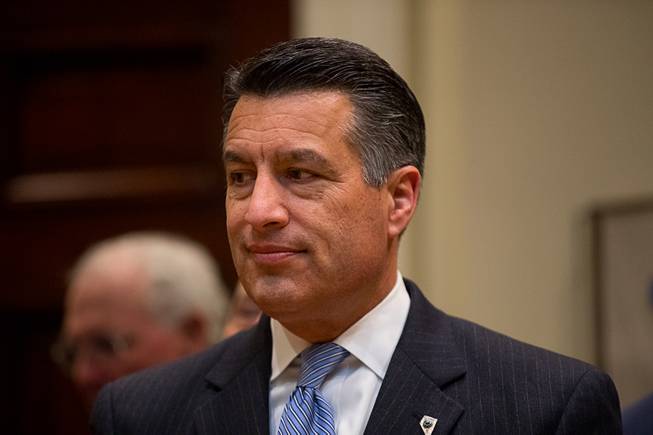
Andrew Harnik / AP
Gov. Brian Sandoval waits for President Donald Trump to arrive for a federalism event with governors in the Roosevelt Room at the White House in Washington, Wednesday, April 26, 2017.
Friday, May 26, 2017 | 10:30 p.m.
CARSON CITY — A proposal from Nevada Gov. Brian Sandoval that would expand the state's efforts to tackle an ongoing opioid crisis with increased data and prescribing protocols made headway at the Nevada Legislature on Friday.
Opioid-related hospitalizations spiked more than 150 percent from 2013 to 2015, according to the most recent data from the state health department. In 2015, 465 Nevada residents died from opioid use — largely owed to prescription painkillers and heroin.
"While Nevada has made progress, the scourge of opioid abuse is tearing our communities apart and I am committed to pursuing and implementing policies that help rid this epidemic once and for all," Sandoval said.
Assembly Bill 474 aims to track overdoses in real time by mandating that doctors and hospitals report to the state any drug overdoses they know of or treat. It passed the Assembly unanimously last week.
That could allow health and safety officials to foresee and respond to overdose trends, Sandoval said in a recent interview. His staff pointed to cases in several Midwestern towns where strings of a dozen or more opioid-related hospitalizations occurred within hours or days, and were later linked to pill peddlers or heroin.
"The state currently tracks rates of overdose, but the most current overdose death data the state has is from 2015 and both Nevada and the problem have changed since then," Sandoval said Friday. "In order for the state to enact policy, or pursue appropriate interventions we need to have data that supports our problem, so we can allocate resources appropriately."
His proposal would mandate that doctors conduct mental health evaluations before prescribing painkillers like OxyContin, Vicodin and fentanyl to patients for the first time, and limit initial painkiller prescriptions to 14-day supplies of no more than 90 morphine-milligram equivalents per day.
Prescribers would have to inform new patients of the risks of dependency and overdose, the availability of the antidote naloxone, other ways to treat the patient's pain including any anti-addiction drug alternatives, and how they would go about refilling the prescription.
Patients would have to consent to more rigorous and recurring assessments to receive longer-lasting painkiller supplies.
After being on painkillers for three months or if they're going to receive a supply intended to last longer than 30 days, patients would have to provide a history of where they were previously prescribed opioids, agree not to share painkillers with others and submit to random counts of their medication.
The bill spells out a list of sixteen considerations doctors must make before prescribing opioids supplies of more than 30 days, including how many times the patient attempted to get the drug or claimed to have lost it, whether they may be doctor-shopping or if the treatment is working as expected.
"Fortunately, most physicians routinely examine a patient before prescribing anything as directed by their standard of care," Sandoval said in a written statement. "However, this law will ensure that all prescribers perform patient evaluations to ensure that they are prescribing the appropriate medications to treat pain and in rare cases identifying patient misuse, abuse and diversion of prescription medications."
For all controlled substances — from opioids to anabolic steroids, Xanax and Adderall — the bill would require doctors to report the reason for prescribing the drug, how long the supply is expected to last and other states where the patient is prescribed controlled substances.
Members of the Senate Health and Human Services Committee unanimously passed the bill on Friday.
The governor and his wife, Kathleen Sandoval, have solicited recommendations over the past three years from hundreds of experts at agencies ranging from the Centers for Disease Control and Prevention to local police departments. They drew in part on the experience of former Vermont Gov. Peter Shumlin.
Sandoval signed the first resulting legislation in 2015. Among other things, it required doctors to contribute to and occasionally review a computerized system that tracks controlled substances prescribed statewide.
